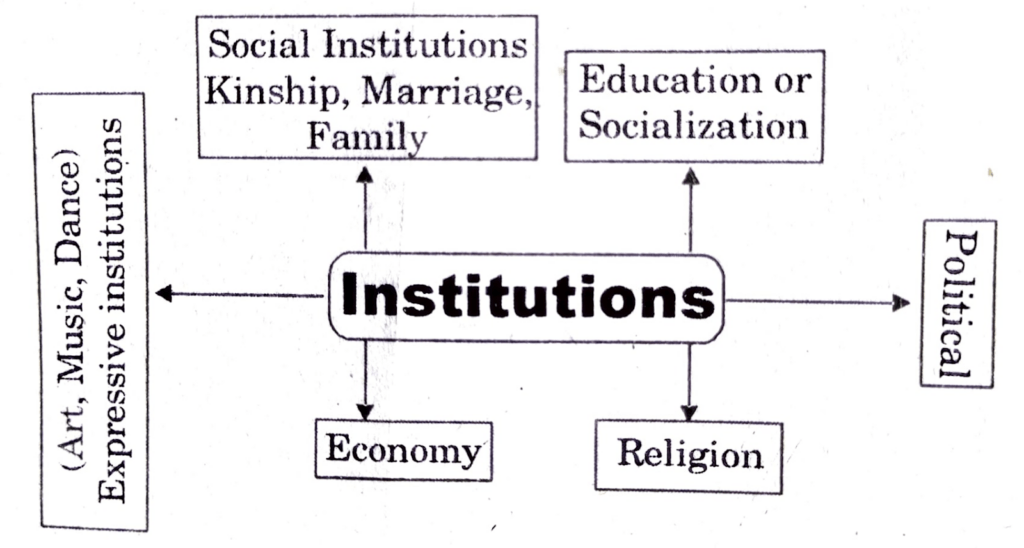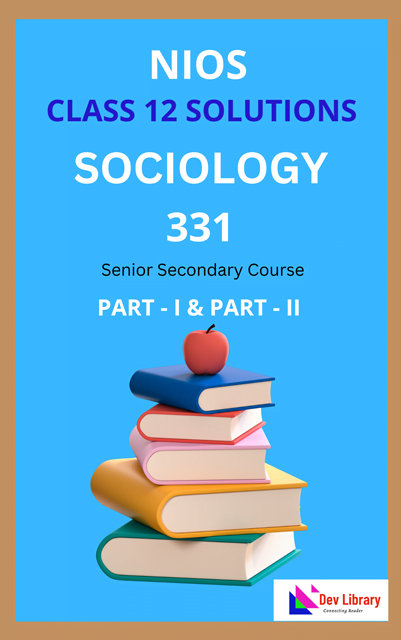NIOS Class 12 Sociology Chapter 5 Society, Community, Associaiton & Institution, Solutions to each chapter is provided in the list so that you can easily browse through different chapters NIOS Class 12 Sociology Chapter 5 Society, Community, Associaiton & Institution and select need one. NIOS Class 12 Sociology Chapter 5 Society, Community, Associaiton & Institution Question Answers Download PDF. NIOS Study Material of Class 12 Sociology Notes Paper 331.
NIOS Class 12 Sociology Chapter 5 Society, Community, Associaiton & Institution
Also, you can read the NIOS book online in these sections Solutions by Expert Teachers as per National Institute of Open Schooling (NIOS) Book guidelines. These solutions are part of NIOS All Subject Solutions. Here we have given NIOS Class 12 Sociology Chapter 5 Society, Community, Associaiton & Institution, NIOS Senior Secondary Course Political Science Solutions for All Chapters, You can practice these here.
Society, Community, Associaiton & Institution
Chapter: 5
MODULE 1: SOCIOLOGY – BASIC CONCEPTS
INTEXT QUESTIONS 5.1
Write answer in one sentence:
Q.1. Define society.
Ans. Society is a web of social relations.
Q.2. Out of ‘difference’ and ‘likeness’ which one has greater importance for the survival of society.
Ans. Likeness.
Q.3. Husband-wife form a social relationship. Do you agree with the statement.
Ans. Yes.
INTEXT QUESTIONS 5.2
Put a tick (✔) mark against the right answer:
Q.1. Which of the following is an clement of difference between community and society?
(a) Definite locality.
(b) A group of people.
(c) Likeness of interest.
(d) Sentiment of oneness.
Ans. (a) definite locality.
Q.2. Select the correct characteristics of community from the following:
(a) Abstract.
(b) Dynamic.
(c) Concrete.
(d) None of the above.
Ans. (b) dynamic.
Q.3. Which of the following is not an example of community?
(a) city.
(b) village.
(c) town.
(d) none of the above.
Ans. (b) village. and (c) town.
INTEXT QUESTIONS 5.3
(a) Which of the following is an example of an association?
(i) Indian society.
(ii) The Brahmin caste.
(iii) Ladies club.
(iv) Group of hippies.
Ans. (ii) Ladies club. and (iv) Group of hippies.
(b) One of the important distinctions between society and association is that the latter has:
(i) Unwritten rules.
(ii) Written rules.
Ans. (ii) Written rules.
(c) Which of the following has territorial basis?
(i) Society.
(ii) Community.
(iii) Association.
(iv) Group.
Ans. (i) Community.
(d) Which of the following is created by people for a specific goal?
(i) Association.
(ii) Society.
(iii) Community.
Ans. (i) Association.
INTEXT QUESTIONS 5.4
Q.1. Identify an example of institution from the following:
(i) Cricket club.
(ii) Hospital.
(iii) Jail.
(iv) Religion.
Ans. (iv) Religion.
Q.2. Tick the correct choice from the following Institutions represent:
(i) Rule and procedures.
(ii) Human aspect.
(iii) Concrete.
Ans. (i) Rule and procedures.
Q.3. Institution regulates the social life. Do you agree with the statement or not. (Yes/No)
Ans. Yes.
Q.4. Tick the correct choice.
Following are examples of institutions and associations:
(i) School.
(ii) Political party.
(iii) Family.
(iv) Family and Cricket club.
Ans. (iv) Family and Cricket club.
TERMINAL EXERCISES
Q.1. Was society created overnight? Describe in your own words. (V. Imp.)
Ans. 1. Society was not created overnight. Society is term used in everyday life with a particular meaning. A layman often defines society as aggregating or collection of individuals. But in sociology, the term is used in a different sense. It refers to the sum total of the relationship existing between them.
2. In term of common sense, society is understood as a tangible object, where as in sociology it refers to an intangible entity. It is a mental construct, which we realize in every day life but cannot see it.
3. Society is the web of social relationship. And it is always changing. An individual becomes part and parcel of several layer groups through different mutual relationship. There relationships do not occur at random. Rather these are patterned. In short we can say, society as the pattern of social relationships formed through interaction of its members.
Q.2. Distinguish between society and community. (M. Imp.)
Ans. (i) The term community refers to human relationship that are highly personal, intimate and enduring, those where a person involvement is considerable if not total, as in the family, with real friends or a close know group.
(ii) Society refers to everything opposite of ‘Community’, in particular the apparently impersonal, superficial and transitory relationships of its members in a informal way. The relations are re-calculating, rational and self-interesting approach to one’s dealings with other.
(iii) Society includes every relation, which is established between people. They go beyond territorial boundaries. For example, Indians spread across the world feel that they are part of Indian society, demarcation of boundary is meaningless here.
(iv) Sense of belongingness is there, but it is less pronounced than in case of community.
(v) Society is an abstract mental construct.
Q.3. What is difference between association and community? (V. Imp.)
Ans. Difference between association and community:
| Association | Community |
| 1. People organize with a particular purpose in mind. | 1. Community is spontaneously created through social grouping. |
| 2. May be short-lived. | 2. It has more endurance, continunity and has a long past. |
| 3. Importance is attached to the group members and specificity of the goal. | 3. Community as a system of social relationship can exist. |
| 4. Mostly functions through written laws and rules. | 4. It functions through customs, tradition and unwritten laws. |
Q.4. What are primary institutions? Explain with the help of examples.
Ans. Some of the institutions are basic to the survival of any society. Some sociologists call them primary institution. There are six primary institutions found in all societies.
They are:
(i) Economic institutions: (e.g. agriculture, industry or any other occupation).
(ii) Social institutions: (e.g. family, marriage and kinship).
(iii) Political institutions: (e.g. political parties or political groups).
(iv) Education or Socialization: (for instance schools, colleges, universities).
(v) Religion: (for examples, Hinduism, Islam, Christianity, Buddhism, Jainism, Sikhism, etc.).
(vi) Expressive institutions such as music, dance, fine arts and literature, etc.
They are found in all human societies.

5. Give an example of society and describe its prerequisites in 100-200 words.
Ans. Society is web of relationship. For example a group of families, kinship, marriage, caste, neighbourhood, peers, political parties, religions, occupation etc.
In their book on “Society”, Mac Iver and Page define: “Society is a system of usages and procedures of authority and mutual aid, of many groupings and divisions, of controlling of human behaviour and of liberties. This ever-changing, complex system, we call society. It is the web of social relationships. And it is always changing.”
This definition reflects that society is a network of social relationships. An individual is related to other through the ties of kinship, marriage, neighbourhood, caste, occupation, religions, political parties and peers (friends groups). Thus, an individual becomes part and parcel of several layer groups through these different multiple relationships. These relationships do not occur at random. Rather these are patterned. Therefore, sociologists define society as the pattern of social. relationships formed through interaction of its members.
Prerequisites of Society:
The collectivity of individual created society over a long period of time. Sociologists have identified certain attributes of society.
They are:
1. Likeness and differentiation;
2. Inter-dependence;
3. Cooperation and conflict.
1. Likeness and differentiation: In the first place, there should be an aggregate of individuals who share the sense of likeness. No society can come into existence unless its members feel that they are like one another. Members of the family and kin group, persons belonging to the same village or small town and members of the same caste generally have this feeling of likeness. However, the first likeness is that of physiognomy. Man along with other animals cannot make a human society.
However, we cannot say that society is not marked by differentiation. The members of a society differ from one another in terms of caste, class, occupation and education, etc. Even within the family, members differ from one another in terms of gender, age, personality, outlook and personal preferences. However, these differences complement each other in such a way that family stability is maintained. Similar principle is also applicable to wider society where the differences are subordinated to likeness, which is quite essential for maintaining social harmony.
2. Inter-dependence: is another attribute of society. The members of a society depend on one another for its smooth functioning. In a traditional village or your neighbourhood, members of different caste groups depend on each other in every day life. For example, washerman, carpenter, cobbler, ironsmith, bus conductor, Brahmin, sweeper are seen to be doing their own tasks yet depending upon each other. No individual can perform all functions on one’s own. Therefore, individuals depend on each other live in society.
3. Co-operation: is another essential attribute of society. No society can come into existence or continue to persist unless the members cooperate with each other. Co-operation is obtained at every level of society such as interpersonal relationship like:
(a) between husband and wife and other family members.
(b) between neighbours.
SOME OTHER IMPORTANT QUESTIONS FOR EXAMINATION
VERY SHORT ANSWER TYPE QUESTIONS
Q.1. What is the meaning of sociology? What is done by it for understanding relationships between individual life and social processes?
Ans. Sociology is a science of society which focuses on certain basic units to understand how human beings live and carry out their activities. These units provide the basis for understanding relationships between individual life and social processes.
Q.2. Briefly write the meaning of “Association”.
Ans. An association is a group of people, who come together and get organised for fulfillment of specific goals or purpose. Sometimes limited number of goals exist behind such organisations. For example, you may have seen the working of Mohalla Sudhar Samities, or cricket club in your neighbourhood. There are also many other such associations like voluntary associations, music club and trade unions.
SHORT ANSWER TYPE QUESTIONS
Q.1. Define community and briefly make clear its meaning.
Ans. Society is an abstraction (notion, idea, thought) community is a concrete entity. According to sociologists, “whenever the members of any group, small or large, live together in such a way that they share the basic conditions of a common life, we call that group a community.” Thus, a community refers to a group of individuals living in a geographical area. They share the same physical environment and the basic conditions of common living. A neighbourhood or a village are good examples of a community.
Q.2. Mention three similarities between society and community.
Ans. Similarity between Society and Community:
(i) Both are spontaneously created social groups, but a community can also be created with a specific interest in mind.
(ii) Both serve wider ends.
(iii) Members of both have a sense of belongingness.
Q.3. Mention four characteristics of Association.
Ans. Characteristics of Association:
(i) It consists of a group of individuals.
(ii) The people are organized.
(iii) There are certain rules and regulations for the conduct of activities of association.
(iv) These people carry out activities to attain certain specific goals.
Q.4. Write two sets of meanings of the term ‘Institutions’.
Ans. (i) By institution, people generally mean an organisation, for example people call hospitals and schools as institutions.
(ii) However, in sociology the meaning of institution is different. Here, this term is used to understand the ways of doing things.


